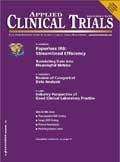Who Will Fund Pharmaceutical R&D?
Applied Clinical Trials
FDA, NIH, industry seek new strategies to support drug development, revive pharma pipeline.
Drug development pipelines have shrunk; fewer new products are being approved for market; and sponsors are scaling back research programs in face of significant declines in revenues due to the looming "patent cliff." Pfizer rocked the industry in February by announcing major cuts in research and development (R&D) spending, including plans to shutter its long-time research facility in Sandwich, UK and to reduce its Groton, Conn. operation.

Jill Wechsler
The pharma crisis is generating a serious search for new product development models. Companies are looking to partner more with small firms and academic research institutes, to shift research and production overseas, and to streamline operations and reduce waste wherever possible. The National Institutes of Health (NIH) seeks to support more translational medicine that will shepherd basic research through the R&D "valley of death" to yield new therapies. Patient advocacy groups are consulting with and funding public and private therapy development programs. These trends promise to alter many aspects of biopharmaceutical development, testing, and marketing.
FDA slowdown?
Blame for longer, more costly drug development falls on the Food and Drug Administration (FDA), which is caught in a hard place: while patient advocates demand earlier access to promising therapies, some policy makers insist on more scrutiny of experimental products to catch potential safety problems early on. However, the resulting demand for more safety and efficacy data adds to development costs and ultimately to less robust pharmaceutical R&D programs. Moreover, success rates remain low for experimental drugs in clinical development, despite years of efforts to streamline research to avoid wasting millions of dollars on unsuccessful studies. Only one in 10 new drugs makes it from Phase I studies to FDA approval, according to an analysis of drug development efforts from 2003 through 2010.
These trends have had a toll on new drug approval rates, which declined in 2010 after two years of slight increases in new drugs moving through the agency. FDA cleared only 21 new molecular entities in 2010, down from 25 a year earlier. Even more discouraging are reports that fewer applications for innovative therapies were filed with the agency last year, squelching optimism about any upturn in product approvals in the near future.
The low approval rate reflects a number of highly touted experimental products that failed to come to market. Cardiovascular safety issues prompted FDA to reject new diabetes therapies and to kill several new weight-loss drugs. A promising fast-acting inhaled insulin product was put on hold following FDA requests for more data on product usage and safety. And some potential cancer therapies fell short of FDA standards.
Amidst the failures are some bright spots. Last month, FDA approved a new melanoma treatment, Yervoy (ipilimumab), touted as the first drug to prolong lives of patients with this deadly skin cancer and a vast improvement over existing therapies. Even better for sponsor Bristol-Myers Squibb is expectations that the mechanism of action for the drug may lead to similar treatments for other cancers. FDA also made headlines earlier this year by approving the first new therapy for lupus in more than 50 years—Human Genome Sciences' Benlysta (belimumab).
Last year's approval list also includes a number of notable products. Amgen won approval for osteoporosis treatment Prolia (denosumab), and Roche's Genentech brought out Actemra (tocilzumab), an intravenous drug for rheumatoid arthritis. Boehringer Ingelheim won the race to bring to market a new blood-thinner with Pradaxa (dabigatran), while new vaccines for meningococcal and pneumococcal diseases won approval. Probably the most exciting new product was Dendreon's therapeutic prostate cancer vaccine Provenge (sipuleucel-T).
BMS cites its success with Yervoy as evidence that an increased focus on pharma R&D can yield big dividends. "R&D pays," stated CEO Lamberto Andreotti, noting that BMS is investing research money very carefully in a range of disease classes and should have four more new therapies approved by FDA in another year. Merck similarly told Wall Street analysts in February that it's not cutting back on its $8 billion R&D spending plans, even though that may mean missing long-term profit forecasts.
Seeking improvement
Meanwhile, FDA officials point out that drug approvals are returning to former on-time schedules after sagging in recent years as the agency struggled to implement a host of new requirements established by the FDA Amendments Act (FDAAA) of 2007. The Center for Drug Evaluation and Research (CDER) is in a "period of consolidation," according to CDER Director Janet Woodcock. In addition to completing FDAAA initiatives, the Center is negotiating a new Prescription Drug User Fee (PDUFA) program and establishing a Quality Management System for a more efficient review process. Woodcock reports that FDA once again is meeting user fee goals for processing applications and that there are more first-cycle approvals, a key benchmark for both sponsors and regulators.
Still, FDA seeks to improve the regulatory process on several fronts. Draft guidance was issued last December on codevelopment of investigational drugs used in combination as part of an effort to encourage more combination therapies. User-fee negotiations are addressing the Risk Evaluation and Mitigation Strategies (REMS) program to meet industry concerns about too many diverse REMS formats. The revised PDUFA program also aims to make pre-submission meetings more productive and to support new strategies for streamlining product testing and application review.
Another area of focus is FDA's accelerated approval process, which is designed to speed important new therapies to market. The system has been criticized because manufacturers often fail to complete agreed-on confirmatory trials in a timely manner, and some fast approvals end up demonstrating limited efficacy and serious side effects in later studies. Now FDA officials are proposing that sponsors launch confirmatory trials before the agency grants any fast-track approval to ensure that the added studies are done.
FDA Commissioner Margaret Hamburg continues to stress the importance of advancing regulatory science for FDA to support a more efficient review and approval process. New biomarkers for toxicology could identify much earlier those drugs headed for failure and also better target therapies to individuals with a greater chance of response, Hamburg notes. In addition, innovative clinical trial designs can yield answers using fewer patients and less money. For new biomedical research discoveries to lead to new products, she explained at the ResearchAmerica forum in March, the gap in regulatory science must be filled.
Push for translation
Cutbacks in industry R&D programs are encouraging more public sector support for pharma research around the world. The Innovative Medicines Initiative in Europe is building a schizophrenia database of industry-sponsored clinical trials to better identify signals of patient response to test drugs. The United Kingdom Medical Research Council has established the Developmental Pathway Funding Scheme to support basic research on drugs and medical devices. Both US and EU scientists are wary of being left behind by soaring Chinese investment in R&D.
At home, NIH Director Francis Collins is campaigning for more translational medicine under a new NIH National Center for Advancing Translational Sciences (NCATS). The initiative will encourage the conversion of basic discoveries into new medicines and diagnostics by bringing together several activities, including NIH's program for developing treatments for rare diseases and its national network of research sites supported by Clinical and Translational Science Awards.
Collins believes that the time is ripe for this kind of initiative. As the former director of NIH's Human Genome Project, he is optimistic that new genetic discoveries can chart pathways to new medical treatments. The scientific enterprise is yielding up a lot of new ideas about therapeutics, he observed in an interview, yet "private sector efforts to capitalize on that are taking a hammering." One consequence, says Collins, is more pharma interest in NIH-funded preclinical and clinical testing, as well as in compound rescuing or "repurposing" projects. Pharma companies have long lists of compounds that have been abandoned along the way, maybe because a business plan changed or clinical trials failed to show efficacy, Collins explains. "This isn't a giveaway, but could be a win-win if such a compound were found to be active for a different application than originally considered."
The NCATS project expects to encourage more collaboration between academic researchers and biopharmaceutical companies and to strengthen NIH ties with FDA to ensure that NIH-sponsored studies provide the data needed to support registration of new products. NCATS, Collins explains, will help re-engineer the drug development pipeline by investing in new assays and research methods. NIH will not move into drug development per se, Collins emphasizes, but will hand promising compounds off to private sector sponsors.
Jill Wechsler is the Washington editor of Applied Clinical Trials, (301) 656-4634 jwechsler@advanstar.com

FDA Fast Tracks Johnson & Johnson’s Nipocalimab for Fetal Neonatal Alloimmune Thrombocytopenia
March 27th 2024Johnson & Johnson is moving forward with a pair of Phase III trials of nipocalimab to reduce the risk of fetal neonatal alloimmune thrombocytopenia in alloimmunized pregnant patients.
Citius Pharmaceuticals Resubmits BLA to FDA for Lymphir to Treat Cutaneous T-Cell Lymphoma
March 19th 2024Pivotal Phase III Study 302 trial data show an objective response rate of 36.2% based on an independent review committee assessment in the treatment of relapsed/refractory cutaneous T-cell lymphoma.